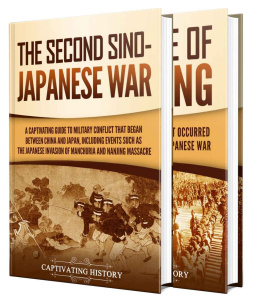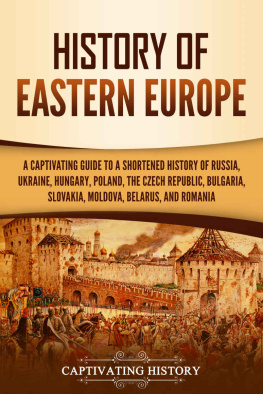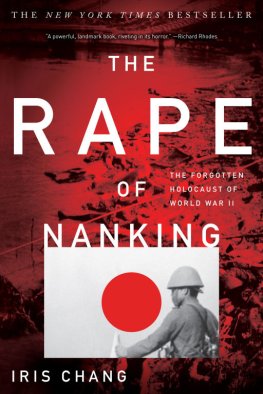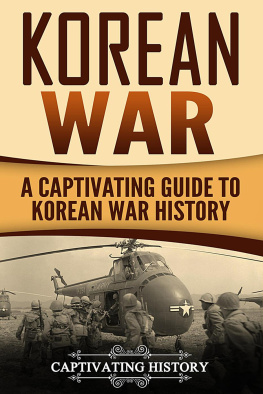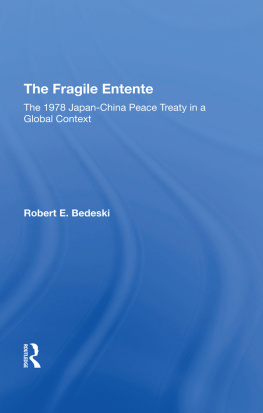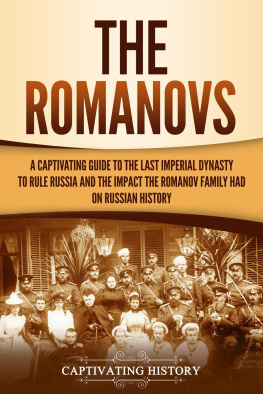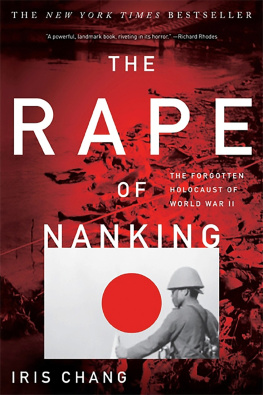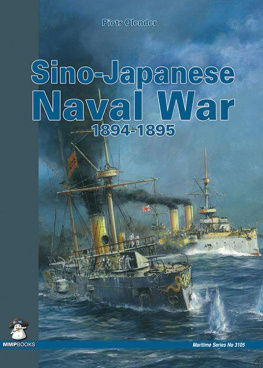Captivating History - Second Sino-Japanese War: A Captivating Guide to a Military Conflict Primarily Waged Between China and Japan and the Rape of Nanking
Here you can read online Captivating History - Second Sino-Japanese War: A Captivating Guide to a Military Conflict Primarily Waged Between China and Japan and the Rape of Nanking full text of the book (entire story) in english for free. Download pdf and epub, get meaning, cover and reviews about this ebook. year: 2021, genre: History. Description of the work, (preface) as well as reviews are available. Best literature library LitArk.com created for fans of good reading and offers a wide selection of genres:
Romance novel
Science fiction
Adventure
Detective
Science
History
Home and family
Prose
Art
Politics
Computer
Non-fiction
Religion
Business
Children
Humor
Choose a favorite category and find really read worthwhile books. Enjoy immersion in the world of imagination, feel the emotions of the characters or learn something new for yourself, make an fascinating discovery.
- Book:Second Sino-Japanese War: A Captivating Guide to a Military Conflict Primarily Waged Between China and Japan and the Rape of Nanking
- Author:
- Genre:
- Year:2021
- Rating:5 / 5
- Favourites:Add to favourites
- Your mark:
- 100
- 1
- 2
- 3
- 4
- 5
Second Sino-Japanese War: A Captivating Guide to a Military Conflict Primarily Waged Between China and Japan and the Rape of Nanking: summary, description and annotation
We offer to read an annotation, description, summary or preface (depends on what the author of the book "Second Sino-Japanese War: A Captivating Guide to a Military Conflict Primarily Waged Between China and Japan and the Rape of Nanking" wrote himself). If you haven't found the necessary information about the book — write in the comments, we will try to find it.
Captivating History: author's other books
Who wrote Second Sino-Japanese War: A Captivating Guide to a Military Conflict Primarily Waged Between China and Japan and the Rape of Nanking? Find out the surname, the name of the author of the book and a list of all author's works by series.
Second Sino-Japanese War: A Captivating Guide to a Military Conflict Primarily Waged Between China and Japan and the Rape of Nanking — read online for free the complete book (whole text) full work
Below is the text of the book, divided by pages. System saving the place of the last page read, allows you to conveniently read the book "Second Sino-Japanese War: A Captivating Guide to a Military Conflict Primarily Waged Between China and Japan and the Rape of Nanking" online for free, without having to search again every time where you left off. Put a bookmark, and you can go to the page where you finished reading at any time.
Font size:
Interval:
Bookmark:
Copyright 2021
All Rights Reserved. No part of this book may be reproduced in any form without permission in writing from the author. Reviewers may quote brief passages in reviews.
Disclaimer: No part of this publication may be reproduced or transmitted in any form or by any means, mechanical or electronic, including photocopying or recording, or by any information storage and retrieval system, or transmitted by email without permission in writing from the publisher.
While all attempts have been made to verify the information provided in this publication, neither the author nor the publisher assumes any responsibility for errors, omissions or contrary interpretations of the subject matter herein.
This book is for entertainment purposes only. The views expressed are those of the author alone, and should not be taken as expert instruction or commands. The reader is responsible for his or her own actions.
Adherence to all applicable laws and regulations, including international, federal, state and local laws governing professional licensing, business practices, advertising and all other aspects of doing business in the US, Canada, UK or any other jurisdiction is the sole responsibility of the purchaser or reader.
Neither the author nor the publisher assumes any responsibility or liability whatsoever on the behalf of the purchaser or reader of these materials. Any perceived slight of any individual or organization is purely unintentional.
Hi History Lovers!
My name is Matt Clayton, and Im the creator of Captivating History. First off, I want to THANK YOU for reading our books in the Captivating History series. As an avid reader of History myself, I aim to produce books that will hold you captive.
Now you have a chance to join our exclusive history list so you can get the ebook below for free as well as discounts and a potential to get more history books for free! Simply click the link below to join.
P.S. If you join now, you will also receive a free Mythology book. Remember that its 100% free to join the list.

Click here to access your bonus
Also, make sure to follow us on:
Twitter: @Captivhistory
Facebook: Captivating History: @captivatinghistory
Youtube: Captivating History
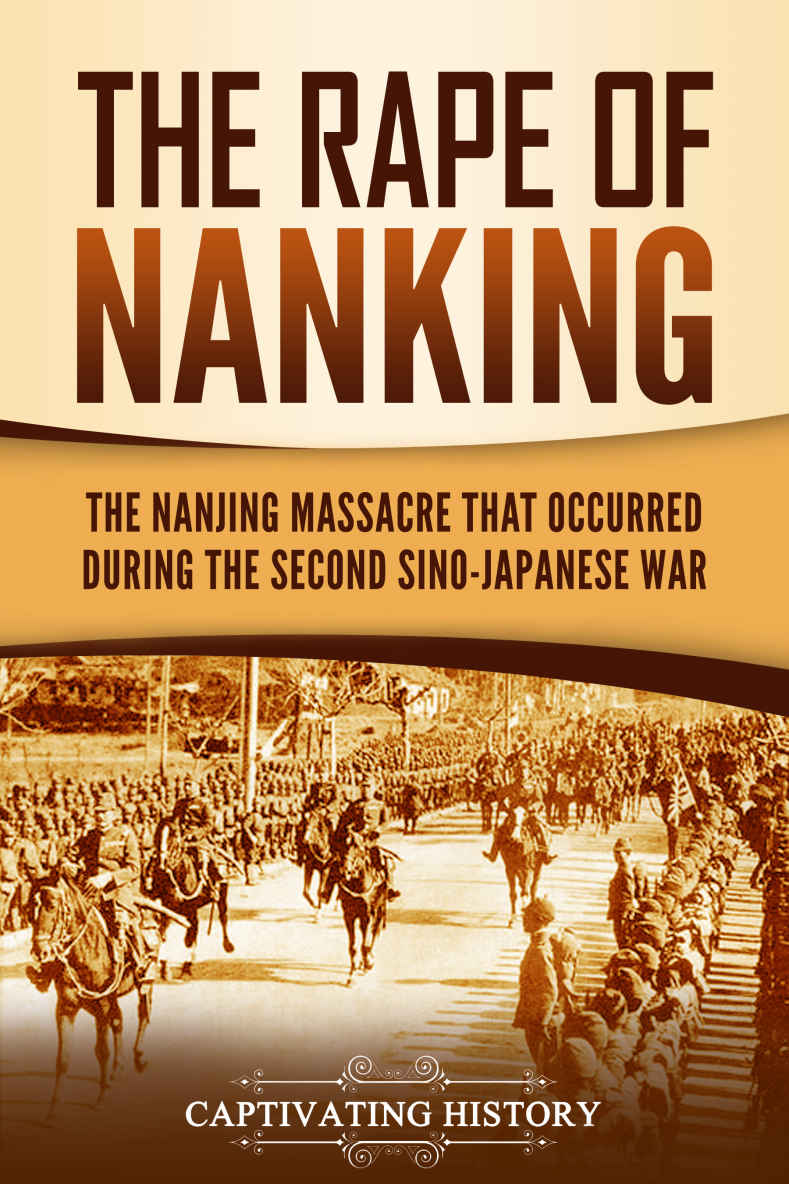
Introduction to One of the World's Bloodiest Conflicts
For most people in Europe, World War II began in 1939 with the German invasion of Poland. Those in the territories of the Soviet Union (conveniently forgetting the Soviet invasion of Finland and eastern Poland in 1939) mark the start of the Great Patriotic War as June 22 nd , 1941, when Hitler's armies attacked their country. Most Americans mark the beginning of the war as December 7 th , 1941, with the attack on Pearl Harbor by the Japanese. It's all a matter of perspective.
Circle around the world to Asia, however, and you get an entirely different point of view. Academic historians differ in their opinions, but they usually fall into two camps regarding the start of World War II in Asia: either 1931, with the Japanese invasion of Manchuria, a remote semi-autonomous region of China at the time, or 1936, when the Japanese invaded China proper. In either case, the war in Asia went on far longer than the war in Europe, and it likely cost just as many lives, with most of them being Chinese.
Many people in the West look upon the Second Sino-Japanese War, which took place in the 1930s and 1940s, as a sort of sideshow to the larger Second World War, but there is no separating the two. Imagine the Pacific War, the theater of World War II that took place in the Pacific. If the Japanese were not busy fighting on another front, they would have had millions of more troops available to fight the Americans and the British. In all likelihood, World War II would have ended the same way, but it would have taken much longer and cost that many more lives.
To understand the conflict between these two Asian powers, we have to travel back in time quite a ways, for the story of what is known by many as the Second Sino-Japanese War is long and rooted deep in history.
In China, the war with Japan is called by a variety of names, including the official Fourteen Years' War of Resistance, with it being referred to as the Eight Years' War of Resistance earlier on, and it is also sometimes referred to as part of the Global Anti-Fascist War, which, of course, it was.
In today's Japan, the war is most often referred to as the Japan-China War, but when the war actually began, the Japanese government referred to it as the North China Incident. That changed shortly thereafter when Japan invaded Shanghai, and the war became known as simply the China Incident, which was clearly an understatement. The word incident resulted partially as a result of there being no formal declaration of war and also due to Japans desire to downplay their actions to the international audience.
Even today, when it is clear to almost everyone who was to blame for the war in China, some Japanese, within the government and without, call the war the Japan-China Incident. This incident cost upward of twenty million lives.
When World War II broke out in the Pacific, the war in China became the Greater East Asia War, which was far more accurate, as the conflict was fought over thousands of miles and involved, in one way or another, China, Japan, the United States, Great Britain, India, and the Soviet Union.
To understand the Second Sino-Japanese War, we need to go back to the First Sino-Japanese War. However, to understand that war, we need to go back a bit further to examine how the two countries got to that point. Of course, what happened in the centuries before the Second Sino-Japanese War does not bear directly on our subject, but that does not mean it did not have some effect.
Roots
Historians and now genetic ethnologists (those who study the genetic roots of peoples and their migrations) tell us that Japan was originally populated by the Jomon people, a distinct ethnic group that still lives on in the DNA of the Ainu, a people who live in the northern areas of Japan, predominantly on the northern island of Hokkaido, and who are distinctly different from most Japanese. These people are related to many of the indigenous peoples of northern Asia and distantly with the native peoples of North America.
People from the Asian mainland, known as the Yayoi, migrated to Japan and intermingled with the native groups already there; simply put, this resulted in the modern Japanese. This all took place approximately from 300 BCE to 300 CE. Over time, a unique Japanese culture was born.
There are many things at which the Japanese excel, and one of them is absorbing and adapting foreign technologies and cultures into their own. For the first few centuries after their arrival, the Yayoi people, who eventually formed into the modern Japanese, imported much of their culture from the Asian mainland. This included their system of writing, religious and philosophical beliefs, and even clothing and court habits. As time went by, these were changed to fit what was becoming a unique and geographically isolated culture. Chinese characters became Japanese, and ideas such as Buddhism underwent changes and became unique to Japan, for example, Zen Buddhism.
Font size:
Interval:
Bookmark:
Similar books «Second Sino-Japanese War: A Captivating Guide to a Military Conflict Primarily Waged Between China and Japan and the Rape of Nanking»
Look at similar books to Second Sino-Japanese War: A Captivating Guide to a Military Conflict Primarily Waged Between China and Japan and the Rape of Nanking. We have selected literature similar in name and meaning in the hope of providing readers with more options to find new, interesting, not yet read works.
Discussion, reviews of the book Second Sino-Japanese War: A Captivating Guide to a Military Conflict Primarily Waged Between China and Japan and the Rape of Nanking and just readers' own opinions. Leave your comments, write what you think about the work, its meaning or the main characters. Specify what exactly you liked and what you didn't like, and why you think so.

